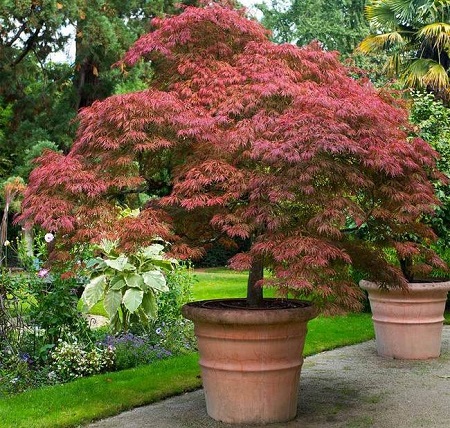
Many people enjoy the beauty of Japanese Maple trees, but some folks don’t have room for another tree in their landscape, or they may be apartment dwellers who don’t have a yard. Fortunately for these folks, there are many dwarf and semi-dwarf varieties of Japanese Maples that can be grown quite well in containers.
Any Japanese Maple can be grown in a pot, but the smaller varieties have naturally smaller root systems and will reside more happily in a container. Larger varieties, such as Bloodgood, will quickly outgrow a pot and would need to be frequently transplanted into larger and larger pots.
If you want to grow a Japanese Maple in a pot, look for dwarf varieties such as Butterfly, Hoshi kuzu, Pixie, Red Elf or Waterfall. There are many more dwarf varieties that can be grown in a pot. Next, choose an appropriate pot for your Japanese Maple. It should be large enough for the rootball to fit comfortably, with plenty of space between the pot and the rootball.
The pot you choose must provide good drainage. Plastic pots work well as they are lightweight and will not crack if they freeze in the winter. Avoid terra cotta pots because they will crack when frozen. If the pot is to be kept on a deck, it should be elevated slightly so water can drain from the pot without damaging the deck.
Plant your tree at the same depth it was at in the nursery pot and keep the soil moist, but not soggy. Fertilize the potted plant weekly with half-strength liquid fertilizer from spring through mid-summer and stop fertilizing after the end of July.
Avoid keeping your potted Japanese Maple in a hot, sunny place or where it will get a lot of wind. They prefer morning or late afternoon sun, with shade during midday.
Japanese Maples should be overwintered outdoors so the trees can go dormant in the winter. Keep in mind that potted plants lose at least one, if not two zones of cold hardiness because of the cold air circulating around the pot and the plant’s roots. Keep the plant outdoors, but in cold climates bury the pot in the ground over winter if you can.
Japanese Maple roots will be damaged if the temperature drops below 10 degrees Fahrenheit.
Mike McGroarty is the owner of McGroarty Enterprises and the author of several books. You can visit his website at FreePlants.com and read his blog at MikeBackYardNursery.com.
Related Articles & Free Email Newsletter
How to Build a Simple Homemade Plant Propagation System
How to Care For an Indoor Ficus benjamina


Comment here